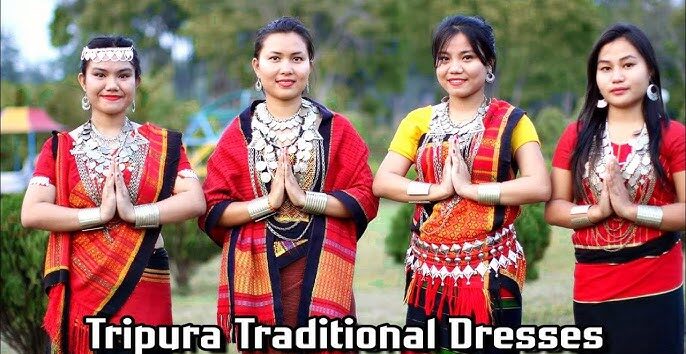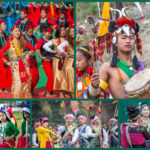Tripura, an enchanting state in northeastern India, is celebrated for its rich cultural heritage, art, and distinctive traditional attire. The traditional dress of Tripura is renowned for its vibrant designs and unique patterns, setting it apart from other northeastern states. This article explores the traditional clothing worn by both men and women in Tripura, showcasing their deep cultural significance.
Traditional Dress of Men in Tripura
Kamchwlwi Borok
One of the most recognizable traditional dresses for men in Tripura is the Kamchwlwi Borok. This colorful garment is essentially a Tripuri shirt or jacket adorned with intricate patterns. Typically featuring a red base, the Kamchwlwi Borok is decorated with horizontal and vertical designs that add to its visual appeal. It is a staple in the daily wardrobe of many Tripuri men, reflecting both tradition and style.
Rikutu Gamcha and Kubai
The Rikutu is a small triangular piece of cloth, akin to a towel, often wrapped around the waist. Complementing this is the Kubai, a traditional shirt worn over the Gamcha. This attire is integral to the traditional dress of men in Tripura, combining practicality with cultural significance.
Pandri
The Pandri is a small cloth, similar to a towel or napkin, used primarily by Reang tribe men. It serves as a modest covering for the lower waist, representing a simple yet essential part of their traditional attire.
Kamchi
Distinct from the turbans or pagris of northern India, the Kamchi is a basic piece of cloth worn by Tripuri men to cover their heads during the summer. This traditional headgear provides both protection and comfort.
Traditional Dress of Tripuri Women
Rignai
For Tripuri women, the Rignai is a significant piece of traditional attire used to cover the lower part of the body. Typically plain black with white vertical and horizontal stripes, the Rignai measures 1.6 meters in length and 1.2 meters in breadth. Its simplicity and elegance make it a fundamental part of the traditional dress of Tripura.
Risa
The Risa is a vibrant, long piece of cloth that covers the upper body. Measuring 1.5 meters long and 0.3 to 0.5 meters wide, it is handwoven with various patterns and designs. Traditionally made in blue and black, the Risa may also come in red. This garment, which features two layers for secure closures, exemplifies the traditional craftsmanship of Tripura.
Rikutu
Another traditional attire for women is the Rikutu, which covers the entire body and is typically worn during the winter months. The Rikutu drapes over the shoulders and back, with the end portion of the cloth covering the chest, much like a saree. This attire underscores the blend of practicality and tradition in Tripuri clothing.
Rinanybaorok
The Rinanybaorok consists of a long piece of cloth used to cover the lower body below the waist. This traditional garment is essential for daily wear and reflects the simplicity and grace of Tripuri attire.
Jewelry Worn by Women in Tripura
Surang
Surangs are traditional hairpins used by Tripuri women to enhance their appearance. These decorative accessories add a touch of elegance to the overall look.
Mathia
Mathias are cylindrical bangles worn on the hands, resembling round bangles but with a distinct cylindrical shape. They are a key part of Tripuri jewelry.
Wakhum and Twaya
Wakhum and Twaya are exquisite earrings typically worn during special occasions such as ceremonies and weddings. Their intricate designs make them a cherished part of Tripuri jewelry.
Bali and Bitan
The nose rings known as Bali and Bitan are beloved by Tripuri women. These traditional nose rings enhance the beauty of the attire and are integral to their traditional dress.
Yasitam and Faru
Yasitam refers to finger rings, while Faru are charming anklets worn during auspicious occasions such as weddings. Both pieces of jewelry add a touch of elegance and significance to traditional outfits.
Conclusion
The traditional dress of Tripura, with its vivid colors, intricate designs, and unique clothing styles, is a testament to the state’s rich cultural tapestry. From the everyday Kamchwlwi Borok worn by men to the exquisitely handwoven Risa for women, each piece of clothing tells a story of tradition and artistry. The addition of beautiful jewelry further enhances the traditional attire, making it not just clothing but a celebration of cultural identity. The traditional dress of Tripura continues to captivate and reflect the vibrant heritage of this remarkable state.


